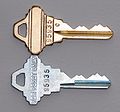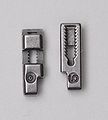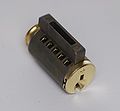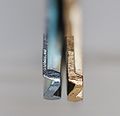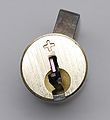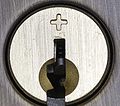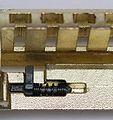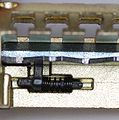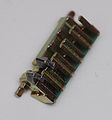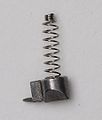Schlage SecureKey: Difference between revisions
From Lockwiki
Jump to navigationJump to search
(Added pictures) |
mNo edit summary |
||
| Line 13: | Line 13: | ||
The '''SecureKey''' is a user-rekeyable [[wafer]] lock made by [[Schlage]]. It uses five wafers that interact with a [[sidebar]] to provide protection against [[lockpicking]] and [[key bumping]]. The SecureKey is similar in design, functionality, and name to the [[Kwikset SmartKey]]. The rekeying mechanisms of both locks have considerable differences, however. | The '''SecureKey''' is a user-rekeyable [[wafer]] lock made by [[Schlage]]. It uses five wafers that interact with a [[sidebar]] to provide protection against [[lockpicking]] and [[key bumping]]. The SecureKey is similar in design, functionality, and name to the [[Kwikset SmartKey]]. The rekeying mechanisms of both locks have considerable differences, however. | ||
The SecureKey can be identified by the traditional | The SecureKey can be identified by the traditional Schlage C keyway warding and the + above the keyway. | ||
Revision as of 17:37, 17 November 2010
Schlage SecureKey
| Schlage SecureKey | |
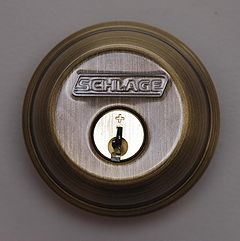 | |
| Name | Schlage SecureKey |
|---|---|
| Manufacturer | Schlage |
| Lock Type | Cylinder |
| Lock Design | Wafer,Hybrid |
| Year(s) Produced | 2010 - Present |
| Patent | US 12/138,950 |
The SecureKey is a user-rekeyable wafer lock made by Schlage. It uses five wafers that interact with a sidebar to provide protection against lockpicking and key bumping. The SecureKey is similar in design, functionality, and name to the Kwikset SmartKey. The rekeying mechanisms of both locks have considerable differences, however.
The SecureKey can be identified by the traditional Schlage C keyway warding and the + above the keyway.
Principles of operation
Add to me!
Rekeying instructions
In order to rekey the Secure Key you need to have a reset key for the current bitting and the desired bitting.
- Insert the reset key for the current bitting.
- Rotate the plug 10 ° to the left (counter clockwise). The plug should click into place as the guide pin housing disengages the wafers.
- Remove the reset key and insert the reset key for the desired bitting.
- Rotate the plug back to the default position and remove the reset key.
- Test the new working key.
Notes
- Do not return the plug to the default position without a reset key inserted.
- Do not attempt to reset the key bitting with a blank reset key. Some wafers may not engage the guide pins and the lock will be non-functional.
- If any errors occur you can always completely disassemble and resassemble the lock to return it to a working condition.
Disassembly instructions
- Remove the cam or C-clip.
- Remove the plug from the cylinder. You may have to raise the wafers so they do not block removal of the plug.
- From here the guide pin housing and guide pins can be removed, then the wafers and the guide pin housing spring.
Notes
- Using a working key to position wafers and guide pins is recommended when re-assembling the lock.
- The guide pin housing is difficult to re-assemble if you do not have prior experience with the lock.
Vulnerabilities
The SecureKey may be vulnerable to one or more of the following:
Notes
- The SecureKey cannot be bumped because it does not use pin-tumbler components.
- Various decoding and destructive attacks against the Kwikset SmartKey also work against the SecureKey.
Gallery
References
